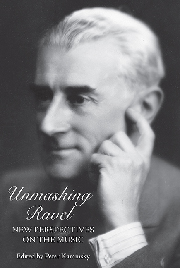Book contents
- Frontmatter
- Dedication
- Contents
- Acknowledgments
- Introduction
- Part One Orientations and Influences
- Part Two Analytical Case Studies
- 4 Ravel's Approach to Formal Process: Comparisons and Contexts
- 5 Repetition as Musical Motion in Ravel's Piano Writing
- 6 Playing with Models: Sonata Form in Ravel's String Quartet and Piano Trio
- 7 Spiral and Self-Destruction in Ravel's La valse
- 8 Diatonic Expansion and Chromatic Compression in Maurice Ravel's Sonate pour violon et violoncelle
- Part Three Interdisciplinary Perspectives
- List of Contributors
- Index
4 - Ravel's Approach to Formal Process: Comparisons and Contexts
from Part Two - Analytical Case Studies
Published online by Cambridge University Press: 05 September 2013
- Frontmatter
- Dedication
- Contents
- Acknowledgments
- Introduction
- Part One Orientations and Influences
- Part Two Analytical Case Studies
- 4 Ravel's Approach to Formal Process: Comparisons and Contexts
- 5 Repetition as Musical Motion in Ravel's Piano Writing
- 6 Playing with Models: Sonata Form in Ravel's String Quartet and Piano Trio
- 7 Spiral and Self-Destruction in Ravel's La valse
- 8 Diatonic Expansion and Chromatic Compression in Maurice Ravel's Sonate pour violon et violoncelle
- Part Three Interdisciplinary Perspectives
- List of Contributors
- Index
Summary
Precious little has been written about Ravel's approach to form. Even in works purporting to catalogue all the salient aspects of Ravel's musical language, the discussion of form is conspicuously absent. For example, in Vladimir Jankélévitch's well-known study of Ravel, the headings under his second section, “Skill,” comprise chapters entitled “Challenge,” “Artifice,” “Instrumental Virtuosity,” “Rhythms,” “Harmony,” “Modes,” and “Counterpoint.” One possible reason is the widespread assumption that for Ravel, form means little more than the choice of a conventional vehicle with which to convey his innovations in harmony, orchestration, and sonority. As Charles Rosen notes, “[Ravel's] musical forms are generally impeccable, if uninteresting, and almost in all cases adequate to convey the fantastic originality of his concern with sound.” A second reason is simply the difficulty of writing about form without taking a purely textbook approach: i.e., creating a taxonomy of formal hierarchy.
This is unfortunate, because form clearly is of vital importance to Ravel in his compositional thinking. In his own writings, he tends not to discuss form in his or other composers' works unless he regards it as deficient. (We shall see this below in his attitude toward Debussy.) His commentary, however, does provide some clue for what is evident over the course of his oeuvre: for virtually every work that he wrote, the formal process—which includes the formal hierarchy as well as the diachronic progress of its unfolding, in conjunction with tonal, harmonic, rhythmic, and thematic/motivic elements—is essentially sui generis.
- Type
- Chapter
- Information
- Unmasking RavelNew Perspectives on the Music, pp. 85 - 110Publisher: Boydell & BrewerPrint publication year: 2011

